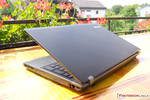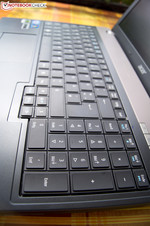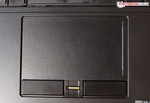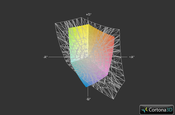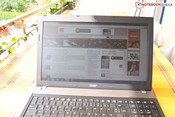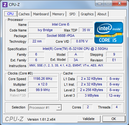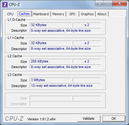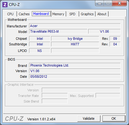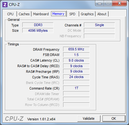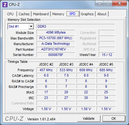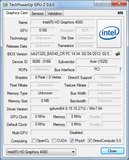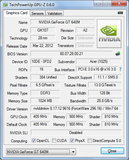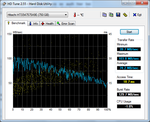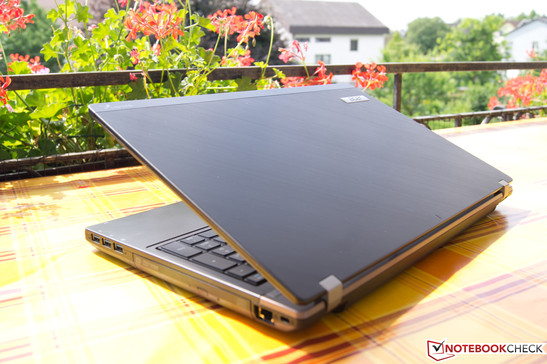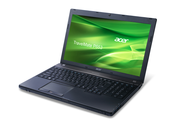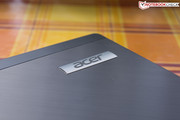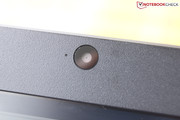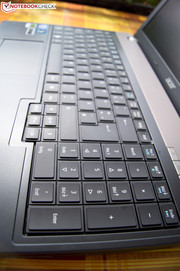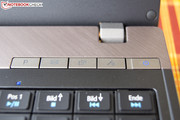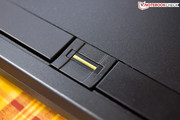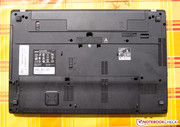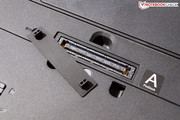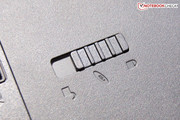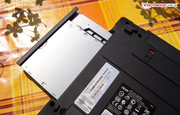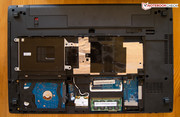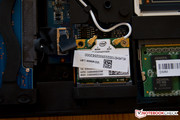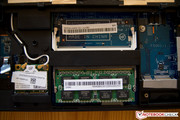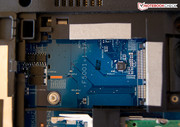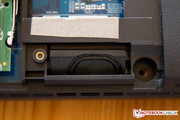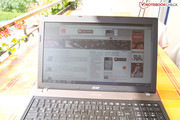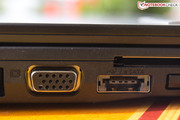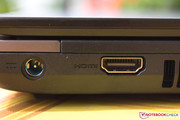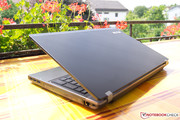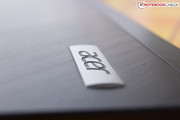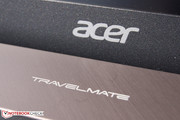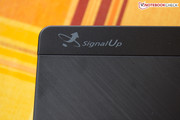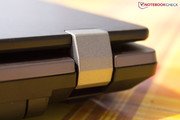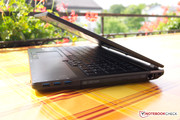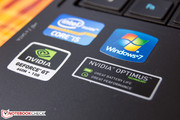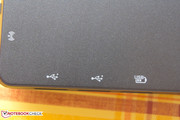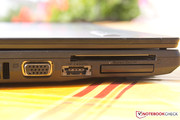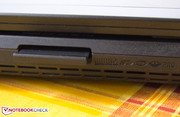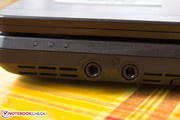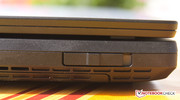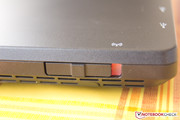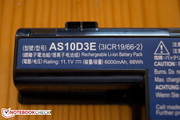Review Acer TravelMate P653 Notebook

The market for affordable business notebooks is being hotly contested. Several manufacturers often try to appeal to customers with less conspicuously conceived devices. When it comes to features and prices, the competition becomes less well defined though. In this case Acer provides stiff competition for itself with the smaller Travelmate P643. Others that shouldn't be forgotten are HP's Probook 6560b and the Lenovo Thinkpad L530, both of which also seek to attract the same buyers as the new Travelmate, and both of which provide a display with a greater resolution. Last but not least, the Dell Vostro 3560 is also a competitor.
It should be obvious that the value for money proposition will likely be the main buying criteria for users, rather than a trendy design. For this reason buyers in this segment will often find themselves glancing at black or dark-gray straight edged notebooks, which merely gain some color from their hardware description stickers. How does our reviewed device stand out in this case then? Can the Travelmate P653 compete with its competition?
Case
Similar to the smaller P643, the P653 also makes a thoroughly convincing first impression. What we have in front of us is a well manufactured and solid 15.6-inch notebook, with a restrained design from the Timeline series that we are already familiar with. The shiny metallic black brushed aluminum surface of the lid looks very good. The following practical test however, showed that many surfaces could just as well be plastic judging by their feel. This doesn't matter though as they feel just as good as the input devices and the palm rest.
With its depth of about 3 centimeters, the notebook is not exactly thin, but the slightly rounded edges and the beveled sides make it appear more streamlined. The massive looking construction can easily be forgiven though, thanks to the good case stability promised by its appearance holding true - no creaking or bending to impair the impression, thanks to the magnesium case. At 2.6 kg the notebook can also be held with one hand and moved around. Looking at the side of the Travelmate, it immediately becomes obvious that the design has been entirely focused on functionality. On both the right and left sides, there is hardly a square centimeter which hasn't been used for interfaces or cooling fan vents.
On the bottom of the case two further goodies can be found, which are also provided by the P643. On the one hand two drainage points which should collect and funnel out fluids spilt on the keyboard, and on the other a small opening for pressured air cleaning of the cooling fan "from the outside".
Even the opening of the notebook was considered for ergonomics with a matte plastic holding rail attached to the front of the lid, so that the fingerprints stay away from the surface and remains nice and shiny. The metal hinges make a robust impression, and allow the lid to be lifted up very easily, while also holding the display in place very firmly without a lot of wobbling. The working area which now becomes visible will be elaborated upon later. First of all we will take a closer look at the features of the P653.
Connectivity
In the segment of 15.6-inch notebooks, no manufacturer will want to be criticized for not including or supporting an important standard as far as interfaces or expansion possibilities are concerned. In light of this observation, our reviewed Timeline device provides all the interfaces a buyer could ask for.
Monitors can be connected via HDMI, and Acer also hasn't forgotten that VGA ports are still in use and are often required for use with older projectors.
The USB 3.0 standard is already a year old, and three of them are available towards the front on the right side of the notebook. Unfortunately the ports are relatively close together and thicker USB sticks could get in each other’s way by blocking a port. One USB 3.0 port is a Powered-USB port, and can also charge smartphones or other portable devices even if the notebook is in standby mode. On the left side there is also a combined USB 2.0 / eSATA port. With the exception of the not very well established Thunderbolt port, all the standards for connecting external data storage devices are available.
Furthermore, Acer has also included both the ExpressCard standards with separate sockets, as well as a SD/MMX/XD/Memory Stick reader along with an RJ45 LAN port and DVD drive.
The following points are only described briefly here as a more detailed description is available in the review of the identical Travelmate P643 model.
Communication
Connecting to different networks with the P653 wirelessly is possible via WLAN (Intel Centrino 6235) using the standards b, g and n, or alternatively by using a hard wired Gigabit LAN (Broadcom NetXtreme) connection. The WLAN card also supports Bluetooth 4.0. In addition, Intel's Wireless Display technology is also supported.
Security
Along with the Kensington Lock port, Acer has also equipped the Travelmate P653 with TPM (Trusted Platform Module) as well as a fingerprint reader. From the BIOS security tools, it is possible for the encryption of important data.
Accessories
On the bottom of the case, underneath a rubber cover is a port for connecting a docking station, which expands the available interfaces further and represents a clear improvement over the previous models. A solution can be found in the price range of around 170 Euro, which also provides additional interface standards such as DVI support.
Maintenance
A maintenance panel on the bottom of the case comes with a few cross head screws which separate the user from the important internal components like the hard drive and the RAM. These can be changed without a great deal of effort. There is also no warranty seal, so there is nothing standing in the way of upgrading the important components.
Warranty
Acer provides the Travelmate P653 with an international warranty of 12 months, and a bring-in warranty of 24 months. Those wanting to extend the warranty by an additional two years can do so for about 139 Euros.
Input Devices
Keyboard
The design of the work area is conservative and appears minimalistic, although we instantly felt comfortable. The palm rest and the whole keyboard area, as well as the touchpad buttons have a rubbery feel and are very pleasant to interact with. Above the keyboard is a decorative panel which is composed of similar materials as the lid, with the exception of the color being dark-gray. At its center is the "Travelmate" logo engraved into the brushed surface with small letters. On the right side above the number pad, there are quick-start buttons (among these is a programmable button, a button for email, a button for the backup manager, and one for deactivating the microphone).
The layout of the keyboard conforms to the usual standards which is good. All the keys, including the ones in the region of the number pad (which is not present on the P643) are fully sized, and accidental typing mistakes are therefore unlikely. One thing new users of Acer will have to get used to though, is the fact that the Euro and Dollar symbols have their own keys, which are placed to the left and right above the arrow keys.
The typing feel is impressive. The pressure point is a little hard, but well defined, and the key travel is relatively longer when compared to the majority of chiclet keyboards nowadays. As far as the style of the keys is concerned, Acer has clearly looked at the chiclet design and tried to modify it in its way to offer the best typing experience it can. The keyboard in the P653 is a common floating keyboard without a large gap between the individual keys. The typing feel is better than most other notebooks.
Touchpad
Acer knows how to make good use of the available space, and equips the P653 with a generously dimensioned touchpad, with individual buttons that are soft to click, and a fingerprint reader between them. The touchpad buttons certainly belong among the better ones, with a well-defined pressure point, and good travel. Meanwhile it is also slightly bigger than that of the already highly praised, and identical, touchpad in the P643.
The touchpad is located directly below the space bar, and should therefore help avoid accidental mouse movements while typing. Nevertheless, this was difficult to avoid in some cases during our test, partially due to the impressive size of the touchpad.
Finger movements are converted into pointer movements very precisely, and the surface of the touchpad is slightly roughened, thus preventing fingers getting stuck. Multi-touch gestures such as pinch-to-zoom or the popular two-finger-scrolling are available and work well.
All in all, Acer has provided users with very good input devices.
Display
The Travelmate comes with a 15.6-inch matte TN-panel display from the manufacturer AUO (B156XW04 V6), with a resolution of 1366x768 pixels, which is standard for a notebook in this category and price range.
It may be cheap, but for a business laptop the picture is acceptable. Of course the color intensity and contrast, as well as illumination, aren't able to keep up with the best, but for working with text, surfing the internet or occasional gaming, the display should be more than good enough. The low resolution is probably one valid area of criticism though. Notebooks of this size often have a full-HD display, or at least a resolution of 1600x900 pixels like its main competitors (Probook 6560b, Thinkpad L530), which are able to provide sharp images and a bigger working area.
| |||||||||||||||||||||||||
Brightness Distribution: 88 %
Center on Battery: 206 cd/m²
Contrast: 156:1 (Black: 1.32 cd/m²)
39.4% AdobeRGB 1998 (Argyll 3D)
55.7% sRGB (Argyll 3D)
37.91% Display P3 (Argyll 3D)
The sRGB color space is not completely covered, but this notebook certainly wasn't conceived for graphic designers or photographers.
The meager contrast ratio of 156:1 can be calculated from the relationship between the high black level of 1.32 cd/m², and the maximum measured brightness of 206 cd/m² (central display area). With an average of around 193 cd/m², the unevenly illuminated display is equipped for use indoors and in the shade. Under sunlight, the backlight is usually too weak to display its content so that it is clearly legible.
The viewing angle stability is sufficient. A slight reduction in color saturation observed when changing the viewing angle is more or less standard among affordable displays. Clear inversion of colors was only observed to be noticeable from extreme viewing angles.
Those looking for a better display, who nevertheless don't want to spend too much, should take a closer look at the Probook 6560b, which has a marginally brighter display, and also covers a larger portion of the sRGB color space, while also providing the resolution of 1600x900 pixels.
Performance
Acer provides the Travelmate P653 in configurations priced between about 800 and 1300 Euro. Buyers can choose between the Core i5-3210M (2x 2.5 GHz - 3.1 GHz) in the reviewed device, or a quad-core Core i7-3612QM (4x 2.1 GHz - 3.1 GHz) processor, as well as having the possibility of changing the 750 GB hard drive (Hitachi) in the reviewed device to a 500 GB hard drive or a 256 GB SSD, and upgrading the RAM to 8 GB instead of 4 GB. A better display is unfortunately not available to choose from.
The value for money winner in this case is the variant for about 800 Euro in our review. If you need video editing but not of professional standard then the performance is more than enough, and also uses less power than the premium model.
The combination of a Core i5, a 750 GB hard drive, and a dedicated Nvidia GeForce 640M may not make the review system a peak performance device, but nevertheless allows it to be a speedy all-rounder. Subjectively there is no reason for criticism when it comes to the performance of the Travelmate, even if it takes a little longer when booting up or starting programs than notebooks equipped with SSDs.
Processor
The new Core i5-3210M Ivy bridge dual-core processor from Intel is one of the most popular processors on the market when it comes to the price to performance ratio. It is widely available in notebooks that are priced in the 800 to 1200 Euro range which are mostly multimedia devices with decent gaming specifications accompanying them.
Not only is this helped by Hyper-Threading technology, which allows each of the processing cores to simultaneously process two threads, but also by Turbo Boost 2.0, which automatically over-clocks individual cores to 3.1 GHz when required.
These features help the Travelmate P653 to good single-core benchmark results during the Cinebench R11 benchmark, and are similar to other models (e.g. Dell Vostro 3560, 2% faster). They can even keep up with current Core i7 quad-core (e.g. 3612QM) processors (exactly just as fast). The results overall only diverge by about 2-8% from each other, and are therefore hardly noticeable in practice, something that is likely due to the Turbo Boost not working as efficiently (permanently 2.9 GHz, with maximum boost of 3.1 GHz merely active every 2 seconds for a short time - see screenshot).
During the multi-core benchmark (Cinebench R11 64-bit multi) however, the Travelmate is outperformed by the faster processor in the Lenovo L530 by 15%, and by the Probook 6560b by 2%. The identically equipped notebooks like the Vostro 3560 and the Travelmate P643, also achieve the identical score as the Travelmate P653. Logically the processor lags behind further during multi-core benchmarks compared to the latest quad-core processors, since these can get more out of each of the available cores. Once again the Travelmate is outperformed by 3% compared to identically equipped competitors. Nevertheless, in this case the performance scores are more or less in line with those from a Core i7-720QM, which was one of the first quad-core i7 notebook processors from Intel.
Thus all the required application areas are a possibility, which span from office use to gaming, and occasional editing of HD videos, while serious video editing users will likely want to select faster quad-core processor configuration.
System Performance
With both PCMark Vantage, as well as PCMark 11, which give an indication of the entire system performance in practice, the Travelmate P653 lags behind slightly compared to its competition.
In these cases, scenarios like video editing, video decoding and internet browsing are tested. When it comes to PCMark Vantage, the reviewed device is outperformed by the Dell Vostro 3560 by about 5%, while this increases to about 10% in the case of PCMark 11. And the Probook 6560b is 26% or 8% faster respectively. Thus our reviewed device is last in line compared to its competitors.
Subjectively the perceived performance and speed doesn't provide any cause for criticism, and the Travelmate is an average notebook with a standard hard drive. A comparison with the competition is therefore worthwhile in order for users to make a better assessment based on their priorities between price and performance.
| PCMark Vantage Result | 6074 points | |
| PCMark 7 Score | 1969 points | |
Help | ||
Storage Devices
All in all, the common 2.5-inch magnetic hard drive with a capacity of 750 GB from Hitachi is an average HDD, considering its rotational speed of 5400 rpm with a cache of 16 MB. The maximum data transfer rate we measured was 103.8 MB/second. The average transfer rate of 74.2 MB/second is also a mediocre value, with which the notebook positions itself in the lower range of similarly equipped competition.
When booting the operating system many small files are loaded. The primary factor determining its speed is measured by CrystalDiskMark. The measured 4k read speed of 0.37 MB/second is 36% slower than that measured with the hard drive in the Vostro 3560, 33% slower than that measured for the Thinkpad L530, and 10% slower than that of the Probook 6560b but about 7% faster than the read speed measured for the 13" Macbook Pro. These values are however all slow compared to the speeds reached with an SSD, which outperform common hard drives by a huge margin.
Graphics Card
Inside the Acer Travelmate P653, the Intel HD Graphics 4000 integrated into the processor is supported by a dedicated Nvidia GeForce GT 640M. Both of these graphics solutions automatically alternate depending on the graphics requirements, thanks to Nvidia's Optimus technology.
This has the advantage where Intel's frugal IGP solution allows for longer battery life while browsing the web or watching a video, while allowing the GT 640M to render 3D images while gaming. The latter is based on the Kepler architecture which combines potent performance with relatively good power efficiency. The performance of the GPU lies between that of a GT 555M, and a GTX 460M from the latest generation, which should allow for the latest games to be played with medium to high settings using the native resolution of the notebook.
The 3DMark 11 results lie on more or less exactly the same level as identically equipped notebooks (e.g. the smaller P643, and the Gigabyte U2442N). The Vostro 3560 lags behind by 31% (is however equipped with a weaker Radeon HD 7670M), while the Probook 6560b only performs about a third as well in terms of graphics performance compared to our review device.
| 3DMark 06 Standard Score | 10599 points | |
| 3DMark Vantage P Result | 6854 points | |
| 3DMark 11 Performance | 1862 points | |
Help | ||
Gaming Performance
The GeForce GT 640M should, at least on paper, be suitable for gaming using medium detail settings. The low standard resolution of the Travelmate P653 of 1366x768, should also allow for higher detail settings to provide smooth gameplay.
Taking a look at the popular shooter Metro 2033, the slim multimedia notebook Aspire Timeline M3-581TG is the Travelmate's biggest competitor (in this price segment with comparable hardware), and is also made by the same manufacturer. In this respect it calculates the individual frames approximately 20% (800x600, low) and 9% (1360x768, medium) faster than our reviewed device. This is somewhat surprising, since the Aspire is equipped with a slower ULV processor. One explanation could be that this produces less heat with a high processing load, and therefore allows the Turbo Boost to be used to a greater extent than our normal TDP notebook processor.
Anno 2070 and Fifa 2011 were tested for benchmarking. Fifa 2011 shows that the graphics card still has a lot of spare processing capacity for higher detail settings. At high detail settings, 146 fps (frames per second) was the maximum frame rate, using the full resolution of the Travelmate. Anno 2070 is also smoothly playable with the GT 640M in the Travelmate using high details with an average of 34 fps.
Users of the business notebook won't have to worry about juddering images in any case when playing up to date games like Anno 2070 and Fifa 2011 where the performance of the GPU nestles in between that of a GT 555M and a GTX 460M. Using an external monitor with a higher resolution is probably not the best idea, since this will also lead to frame rates dropping, which can make the difference between "almost smooth" gameplay and a "slide show". Although the notebook was not conceived for gaming use, it still provides decent performance. Other affordable business competitors from other manufacturers, most of which adopt slower GPUs, would literally "stagnate" like the Vostro 3560 (HD 7670M) which is 41% slower with Anno 2070 using medium details. The smaller P643 should also provide the same gaming performance, considering the identical hardware and 3DMark benchmark results.
| low | med. | high | ultra | |
|---|---|---|---|---|
| Metro 2033 (2010) | 63.5 | 40.1 | ||
| Fifa 12 (2011) | 274 | 161 | 146 | |
| Anno 2070 (2011) | 122.3 | 54.1 | 34.3 |
Emissions
System Noise
At low loads, the Travelmate P653 is pleasantly quiet. During the majority of the test, which includes internet browsing or during office use, the hard drive was the loudest source of noise at 31.9 dB, and the cooling fan was usually inactive (or at least not audible).
When the Travelmate is fully loaded (Prime95 + Furmark for one hour), the cooling fan turns up to 41.2 dB (comparable best value: Thinkpad L530 - 37.8 dB). This may not be extremely loud, but there is an annoying consistent "whistling" sound. During graphics benchmarks this kind is noise is heard. Every time the picture updates, there is a short beep from a transistor inside the device which means a consistent high frequency whistling with faster frame rates.
If this is not our test sample’s error then this could lead to a lot of disappointed buyers of the Travelmate, who also want to use the device for playing games (otherwise the whistling is not noticeable).
Noise level
| Idle |
| 31.9 / 31.9 / 33.1 dB(A) |
| HDD |
| 31.9 dB(A) |
| DVD |
| 34.7 / dB(A) |
| Load |
| 41.1 / 41.2 dB(A) |
 | ||
30 dB silent 40 dB(A) audible 50 dB(A) loud |
||
min: | ||
Temperature
With low processing loads, the P653 stays pleasantly cool. The temperatures on the surface vary between 30.1°C and 35.1°C, and 30.8°C and 38.1°C on the bottom. Our review device stays impressively cool while browsing the net and typing this review and we can also enjoy sitting outside for once.
With the notebook is loaded, the temperatures on the top reach a maximum of 40.5°C (in the center). With an average of 38°C the device may get pretty warm, but not unpleasantly hot and working with the laptop is still possible without problems. The maximum temperature on the bottom surface reaches 48.3°C (area around the cooling fan).
The measured core temperatures permanently stay at 65 - 67 °C (GPU) and 63 °C (processor). There is no throttling of the CPU noticeable following a stress test with both cores running at about 2.9 GHz with Turbo Boost. The graphics card however is throttled down to 135 MHz from 700 MHz. The graphics memory is throttled from 800 MHz to 405 MHz in order for the (rather quiet) cooling system to not be over used. This takes place despite there being temperature reserves available. But we do know that notebook hardware should still be healthy at 80°C. A subsequent 3DMark benchmark even shows a marginally better result than with a cool device. Throttling is therefore only a problem for the graphics card in certain simulated scenarios but not in during practical use.
Compared to the Probook 6560b, and the Thinkpad L530, the Travelmate is slightly warmer. The real frying pan among the candidates is the Vostro 3560 however, with a temperature of up to 53°C on the top with a high processing load. The Travelmate P643 performs similarly to the larger version.
(±) The maximum temperature on the upper side is 41 °C / 106 F, compared to the average of 34.3 °C / 94 F, ranging from 21.2 to 62.5 °C for the class Office.
(-) The bottom heats up to a maximum of 48.3 °C / 119 F, compared to the average of 36.8 °C / 98 F
(±) In idle usage, the average temperature for the upper side is 32.6 °C / 91 F, compared to the device average of 29.5 °C / 85 F.
(-) The palmrests and touchpad can get very hot to the touch with a maximum of 41 °C / 105.8 F.
(-) The average temperature of the palmrest area of similar devices was 27.6 °C / 81.7 F (-13.4 °C / -24.1 F).
Speakers
Users shouldn't expect perfect audio from the two small speakers at the front of the Travelmate.
Extremely high frequency, tinny and undefined, is the best way to describe the frequency response. If it had to be compared to similar devices, the closest thing would probably be a small battery powered radio from the 1980s.
At least the volume can be set quite high such that even medium sized rooms can be filled with sound. The audience won't be happy with the audio quality though, since the high frequencies can sound shrill to the ears at these volumes. In this case, it is better to fall back on external speakers, since these allow for good audio quality.
Battery Life
Power Consumption
The power consumption in idle state can certainly make a good impression for a 15.6-inch notebook. Depending on the settings selected for the backlight of the display, between 8.7 and 12.3 Watts of power are used.
While at full load, the P653 uses an average of 59.1 Watts from the outlet and during extreme scenarios, the maximum value can reach up to 64.3 Watts. This is however a comparatively low value considering the fact that a considerably potent graphics card is also being stretched to its limits. This is something which could also be explained by the throttling experienced during the stress test.
| Off / Standby | |
| Idle | |
| Load |
|
Key:
min: | |
Battery Runtime
A good notebook has to have decent battery life nowadays. And the Travelmate does deliver on this front to an extent.
The touted "8h+" battery life may only be possible under certain circumstances such as the minimal test, with the BatteryEater Readers benchmark, where 9 hours can be achieved by the 66 Wh battery. In this case, users who want to take longer train journeys with a dimmed backlight and inactive WLAN, reading e-books with the power saving profile active, will likely be satisfied with the results.
More closely related to practical use is the WLAN surfing test, where the Travelmate stays on its feet for 5 hours and 24 minutes without the power connected. During this test, some popular websites are repeatedly loaded and Youtube HD videos are played with the backlight set to 150 cd/m². Dell's Vostro 3560 only lasts about 2 hours less with its smaller battery while the Travelmate P643 manages an additional 40 minutes over the P653, and can therefore be recommended to users with battery life as a high priority. The Thinkpad L530 outperforms these laptops, thanks to its 9 cell battery, which makes for a battery life of about 7 hours, although it would probably last a similar amount of time with a 6 cell battery as used in our review device.
If intending to watch DVDs, then the Travelmate should provide about 142 minutes (2 hours and 22 minutes) of viewing time. Most blockbusters should come to an end within the available time without cutting off. In case the notebook is subjected to high processing loads (tested by us with BatteryEater Classic using full brightness and active WLAN), then the total battery life lasts for about 2 hours without the adapter.
Verdict
The impression the Acer P653 made on us was that it was a simple device. In this case nothing is overstated (with the exception of the metallic surface on the lid) and the price is straight forward at 800 Euro, buyers will receive an honest all-rounder, wrapped up in a staid case with magnesium-aluminum accents which is enhanced with soft rubber in important places (input devices, palm resting area).
Of course the display is not suitable for graphic designers and also only has a brightness of around 200 cd/m², and can't really be used under direct sunlight. Furthermore the notebook is not especially thin, and is also not able to provide bass but that is not what it is intended for.
In practice the P653 only stands out due to it being inconspicuous. Users won't get annoyed by an imprecise touchpad with loud hard to operate buttons, or a keyboard layout which can cause typing errors, a loud cooling fan or short battery life. Everything works the way you would want it to.
Acer is providing an affordable and stable package with a lot of storage space as well as a lot of battery capacity, in combination with the latest CPU and graphics card, all of which should cover many application areas.
One thing that really stands out as a negative though, is the whistling sound emitted during gaming which can become as annoying as the high pitched sound from the speakers. Hopefully only our reviewed device was affected by this as we were not able to notice the same issue with the smaller P643. Those making good audio quality one of their priorities should either use external speakers or avoid the Travelmate altogether. If users can come to terms with the disadvantages of the P653, then it could definitely be a good choice as the price is right. Those requiring a higher display resolution and who would be willing to trade this for a slower graphics card, should find competitors like the Thinkpad L530 and the Probook 6560b interesting alternatives for the office. As usual: Bargain hunting is worth it!




